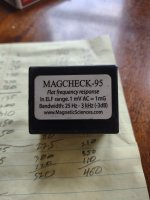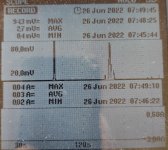One of our forum mods, Karl Riley, wrote the book on EMFs and invented a gaussmeter. His research indicates high levels of EMFs are caused by electricians making wiring violations of the NEC. Search for his video on you tube.
Are you familiar with the inverse square law?
Quite aware. My undergrad was in communication systems. Then I went on to do large industrial systems.
The biological effects have been studied and quantified for years. The limits are set roughly 10 times lower than measurable effects as a safety margin.
To equate this with power systems has two problems. First off most of the utter crap you see uses constant values intended for exposure to microwaves. Why? Because of wavelength. The speed of light is 2.98 x 10^8 meters per second. So if we start with say 10 Gigahertz (10^10) which is on the order of a kitchen microwave oven we end up with a wavelength of 2.98 cm or about 1.2 inches. When a wave hits a conductive object that is substantially larger than 1 wavelength it is either absorbed or reflected.m essentially 100%. On the other hand if a conductive object is less than about 10% of the wavelength most of the wave just passes right through, unaffected. So if a human is exposed vertically with an average length of about 2 meters, wavelengths of 20 meters or more barely interact at all, or about 15 Megahertz. For reference, 60 Hz wavelength is 4,967 kilometers or around 2750 miles. So I really don’t care what a gauss meter reads unless it also takes wavelength into consideration.
Put another way, there is actually an ELF transmitter, the largest radio transmitter in the world. It was featured in the movie Hunt for Red October but like a lot of Tom Clancy stuff, it is real. The operating frequency is somewhat secret but it is close to 60 Hz and in the ELF range. The antenna is much shorter than the owner really wants which makes the efficiency terrible but since it spans two states already over hundreds of miles, it’s about as big as it can reasonably get. The effects on local biology have been extensively studied. Other than the fact that plants seem to grow slightly faster in the area, no other effects have been measured. The power level is also secret but it is far more substantial than even several dozen houses combined. I lived in the area and went to the major engineering university in the area. I have read several reports on the system because hey…engineer aspiring to work on communication systems.. I had a big interest.
The point is that ELF has vastly higher power levels and thus your inverse distance concern is trumped by massively higher power and a much, much larger antenna gain. And even then if the measurable biological effects from the worlds largest ELF system dwarf a residential system yet seems to have no measurable effect on local biology, to put it mildly there is simply no scientific evidence to support all the crazy claims of people somehow being affected. It’s all psychosomatic crap.
I do believe in “stray voltage” of sorts. It does exist around multi grounded systems. Mike Holts group has done a lot to dispel myths. And yes cows are more sensitive but once again it comes down to simple science. Stray voltage is when we have neutral current flowing through the Earth. It’s effectively a version of ground potential rise. As such the distance spanned gives rise to higher voltages. So a cow gets a much more severe shock than I do, especially if I am standing next to her in rubber boots! But this is a far cry different from EMF that travels without direct contact.
So getting back to your statement about EMFs causing a gauss meter to jump. If you recall the original Marconi radio was a spark gap. Electrical arcs are pretty much pure white noise pulses. The rate of rise, dv/dt is pretty easily related directly to the frequency spectrum. However pulses have a cosine roll off and pulsed harmonics, not a continuous wave. So over the range of human susceptibility, roughly 15 MHz+, either the pulse is mostly below that frequency or very low power. High frequency pulses do not travel well in house wiring because the bandwidth has significant toll off above about 10-100 Khz at best. I have seen some HF arcing up into a few MHz in a 3 phase small motor due to what amounts to capacitive discharge caused by excessive dv/dt in a crappy VFD application eating up bearings but that’s as high as you ever get in a power system for extended periods and that’s not a residential scenario. So while I agree it is possible, exposure is very limited except for long exposure times.
Then we get into the exposure time issue. Except for intentional arcs (contacts and some types of surge arresters and discharge lighting), electrical arcs quickly erode away equipment. Testing for arc flash purposes at Kinetrics that does most of the testing sustained an arc at 130 VDC with a 1/4” gap for 0.08 seconds at 20 kA before it self extinguished. That’s a high energy power src, on the order of what you need to generate substantial EMF from an arc, but it’s simply not sustainable. In fact arcs are not sustaining under around 200 V and self sustaining only in special circumstances from 200-300 V. Nothing new here. Marcia Eblen from Duke has published this data via EPRI and IEEE. So the conditions necessary for constant EMF in household wiring don’t exist.
My sister in laws sister claims her kids are affected by EMF fields and that she is too. She has done substantial things to try to stop the waves and rubs around totally out of her mind because of gauss meter readings. The scientific nonsense that she utters plus all her crazy Twitter friends is clear evidence of psychiatric problems. She is into that, too, plus she has a literal tree growing up through the middle of her house. Fortunately I guess she has a good paying job so she can afford her fantasies. I blew her mind when I installed a system in her house that had copper wires connecting an LED light that generated no measurable readings on her gauss meter. I’ll leave it to you to ponder how I managed to power a diode without using AC power.
So excuse me if I don’t entertain these utter nonsense claims by the tin hat society.
So if I’m wrong, show me peer reviewed scientific studies showing substantive biological danger from ELF frequencies of EMF. I don’t care what your microwave oven test does because the wavelengths are completely wrong. I also don’t care what your gauss meter readings are because those things capture everything from 0 to a couple Gigahertz. So unless you are using a capacitor to block everything below a 3 dB point of about 100 MHz or so, your readings are garbage and do not accurately reflect human anatomy. And if you do, you’ll find you no longer read much of anything at all. Now since most of these things are nothing but wide band amplifiers hooked to a stubby broadband antenna, the readings are pretty much garbage in, garbage out.
Just trying to inject scientific reason and logic into what normally amounts to a whole lot of speculation, pseudo-science, and paranoid delusions.
Excuse me while I go run off a couple little green men that seem to have stumbled into my back yard. They are either trying to make crop circles or they are after my cows.


